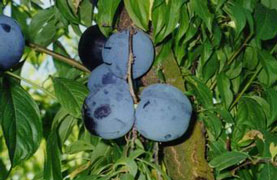


Home
Flowers &
Indoor Plants
Fruits & Nuts
Ornamentals
Vegetables
Special Topics
Resources
Glossary

|
Plum Prunus sp. (proo-nus)   Click on thumbnails for larger image. |
 |
What about it? Plums are in the same genus as peaches, cherries, almonds and nectarines. Prunus domestics is the European plum, and it is the most important plum species worldwide. Of the European plum types, there are prunes such as 'Stanley; Green Gage types, Yellow Egg types, and the Lombard group, which is a group of large red or pink plums. The Oriental or Japanese plum, P. salicina is an important cultivar commercially as well. There are several native species, but although many of them make excellent preserves, these have not achieved economic importance. What is it used for? Plums are usually enjoyed fresh. They are also delicious in baked goods, jams or preserves. Dried plums (prunes) are also a favorite for snacks. Prune juice is also a plum product. Where does it grow? How do we grow it? Plum culture is similar to that of the other stone fruits. Deep, well-drained loams are the best soil, and although a broader range of soil types can be tolerated, plums will not endure wet feet! Like most of the other fruit crops, plums need full sun and perform best on slopes that allow cold air to drain downhill. Growing plums in the coldest parts of New York is questionable! What are its primary problems?Silver leaf reduces the plum tree life. Bacterial leaf spot is a major plum disease. Blast and brown rot are common in wet years. Crown gall, cankers, black knot, bladder plum, aphids, pear slug, scales and leaf roller can also occur. How do harvest and store it? Plums should be carefully hand picked when they are ripe to prevent bruising. They can only be stored at cool temperatures for a limited period of time. Only the best quality plums should be used for canning and preserving.
© Copyright, Department of Horticulture, Cornell University. |